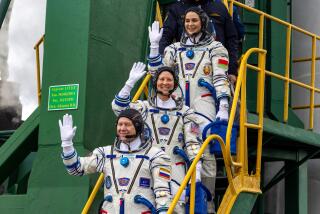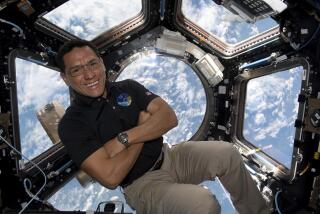Shuttle Finishes First Mission With Cosmonaut
- Share via
KENNEDY SPACE CENTER, Fla. — The space shuttle Discovery and its crew swooped through high clouds and landed safely Friday, ending the first U.S. spaceflight with a Russian cosmonaut aboard.
“You paved the way for a new era of cooperation in human spaceflight,” Mission Control told the five astronauts and one cosmonaut.
Sergei Krikalev became the first Russian to fly on a U.S. shuttle when Discovery left on the science mission Feb. 3.
The crew’s homecoming Friday was delayed 1 1/2 hours, or one orbit, because of thick, low clouds and high winds at the space center.
National Aeronautics and Space Administration officials considered sending the shuttle to Edwards Air Force Base in California, but the sky cleared enough in Florida to allow the midafternoon landing.
Despite the unprecedented partnership, the Discovery crew failed to accomplish one of the primary objectives of the mission--releasing a research satellite.
The Wake Shield Facility, a steel disc, was supposed to fly free of Discovery for two days and develop high-grade semiconductor film in its pure-vacuum wake.
It was hoped that the film eventually could lead to faster computers.
But transmission troubles and a bad guidance system prevented crew members from deploying the satellite. Instead, it developed the film while dangling on the end of Discovery’s robot arm.
In other experiments, a small German science satellite was successfully released Wednesday, as were six metal balls ejected from a cargo bay canister so space debris experts could track them from Earth.
Discovery also carried a small commercial laboratory called Spacehab. Most of the 12 Spacehab experiments involved biotechnology: splitting cells, for instance, and growing protein crystals.
Within minutes of the shuttle’s touchdown, officials at the Russian control center for the Mir space station were on the phone to Mission Control, congratulating their American counterparts on Discovery’s return.
The eight-day shuttle trip boosted Krikalev’s time in space to 471 days, almost all of it aboard Mir.
Americans and Russians flew together during the 1975 Apollo-Soyuz docking mission, but never before had a Russian been launched on a U.S. spacecraft or landed in one.
Another Russian cosmonaut is due to fly on a shuttle early next year, and two Americans head to Russia next week to train for a 1995 stint on Mir.
Up to 10 shuttle-Mir dockings are planned beginning in 1995, with the goal being a joint space station by 2001.
More to Read
Sign up for Essential California
The most important California stories and recommendations in your inbox every morning.
You may occasionally receive promotional content from the Los Angeles Times.










